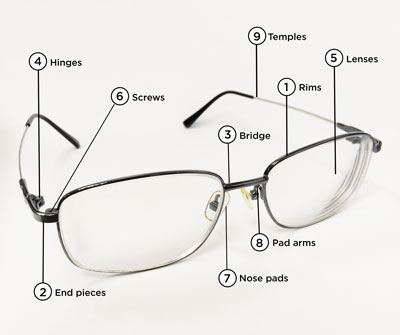Parts Of Glasses
There is no doubt that glasses are complex machines, and each component must work together to ensure that you have a clear vision and that they look fashionable at the same time.
Knowing your glasses anatomy is one part of the solution: it can help you understand the way the parts of your glasses fit together and diagnose any problems that may arise. If your glasses frame breaks or does not function properly, it may be difficult to describe or locate the problem.
Having a better understanding of glasses parts is also valuable when talking with an optical professional. Rather than referring to the “small metal part” or the “long thingamajig on the side,” you will be able to communicate effectively.
Glasses Part Names
The two major components of glasses, lenses and frames, are usually discussed when you are getting an eye prescription from an optometrist.
Lenses
When you wear glasses, you look through the lenses, which are transparent pieces that refract light so that you will be able to see clearly. There are a number of lenses available, each tailored to meet your specific prescription, which allows them to correct your vision issues (nearsightedness, farsightedness, and astigmatism being the most common).
It is important to note that there are a number of different types of lenses and lenses materials. Depending on the prescription, you may need single vision lenses or multifocal lenses, such as progressive lenses.
From your eye doctor, you can inquire about special coatings, tints, and features as well as finding the right lenses for your eyes. Our lenses include antireflective and hydrophobic coatings as standard, but you may also choose to add a blue-light-filtering coating or light-responsive transition lenses.
Frames
It consists of everything that surrounds the lenses. It is likely made of acetate or metal, and its shape and color can be subtle or bold.
In order for frames to sit comfortably in front of your eyes, they are composed of many separate components.
Frame rims: The part of the glasses frame that holds the lenses. They can be round, square, oval, or any other shape that can accommodate prescription lenses.
It is important to remember that some glasses have full rims, while others may be semi-rimless, which means the rims do not extend all the way around the lens. Glasses rims are also referred to as eye wires.
Bridge: The bridge, which runs across the bridge of the nose, supports the majority of the frame’s weight.
It is the bridge of your glasses that determines the comfort and fit, so it is important to choose the one that matches the shape of your face. If you have a wide face, low nose bridge, and/or high cheekbones, you may want to consider Low Bridge Fit glasses.
The top bar, brow bar, and sweat bar: are all terms used to describe an additional bridge above one’s first bridge. They are a fashion statement and an additional style feature.
There is a brow bar (also known as a top bar or sweat bar).
Nose Pads: The nose pads are tiny cushions that sit on the nose to assist with fitting and prevent your glasses from falling off. They are generally made of clear plastic and are commonly used on metal frames. As a result of their inclusion in the rims of acetate frames, nose pads are not required separately.
Pad Arm: A pad arm is the short arm that attaches to the rims of your glasses and holds your nose pads. These small arms are often adjustable so that you can find the perfect fit for your glasses. You will typically find nose pads and pad arms on metal frames, rather than plastic ones.
End pieces: The end pieces are located at the upper, outer corners of the frames. These parts of the glasses frame jut out a little so that they can be connected to the hinges and temples. Additionally, they may be embellished or embellished in a decorative manner to enhance their appearance.
Hinges: Without hinges, your glasses would not be able to fold inwards for convenient storage if you did not have hinges. A hinge is a joint that is connected by a screw to the endpiece of your glasses and the temples or arms of your glasses. It comes in a variety of varieties, but all of them should allow easy movement of your glasses arms.
Screw: screw secures the two halves of a hinge together. This is why glasses repair kits come with a tiny screwdriver! The screws inside your glasses hinges can be tightened, loosened, or replaced, depending on the condition of your frames.
Arms or Temples: Two long, skinny parts of your eyeglasses that attach via the hinge and extend over your ears. The glasses arms are responsible for holding your glasses in place while you go about your day. They can vary in length and shape—some glasses arms may have dramatic curled ends, while others may be straight.
Temple tips: Also known as earpieces, these are the ends of each temple (or arm). The temple tips of metal glasses are sometimes made from a different, more comfortable material, which helps prevent skin irritation.
















